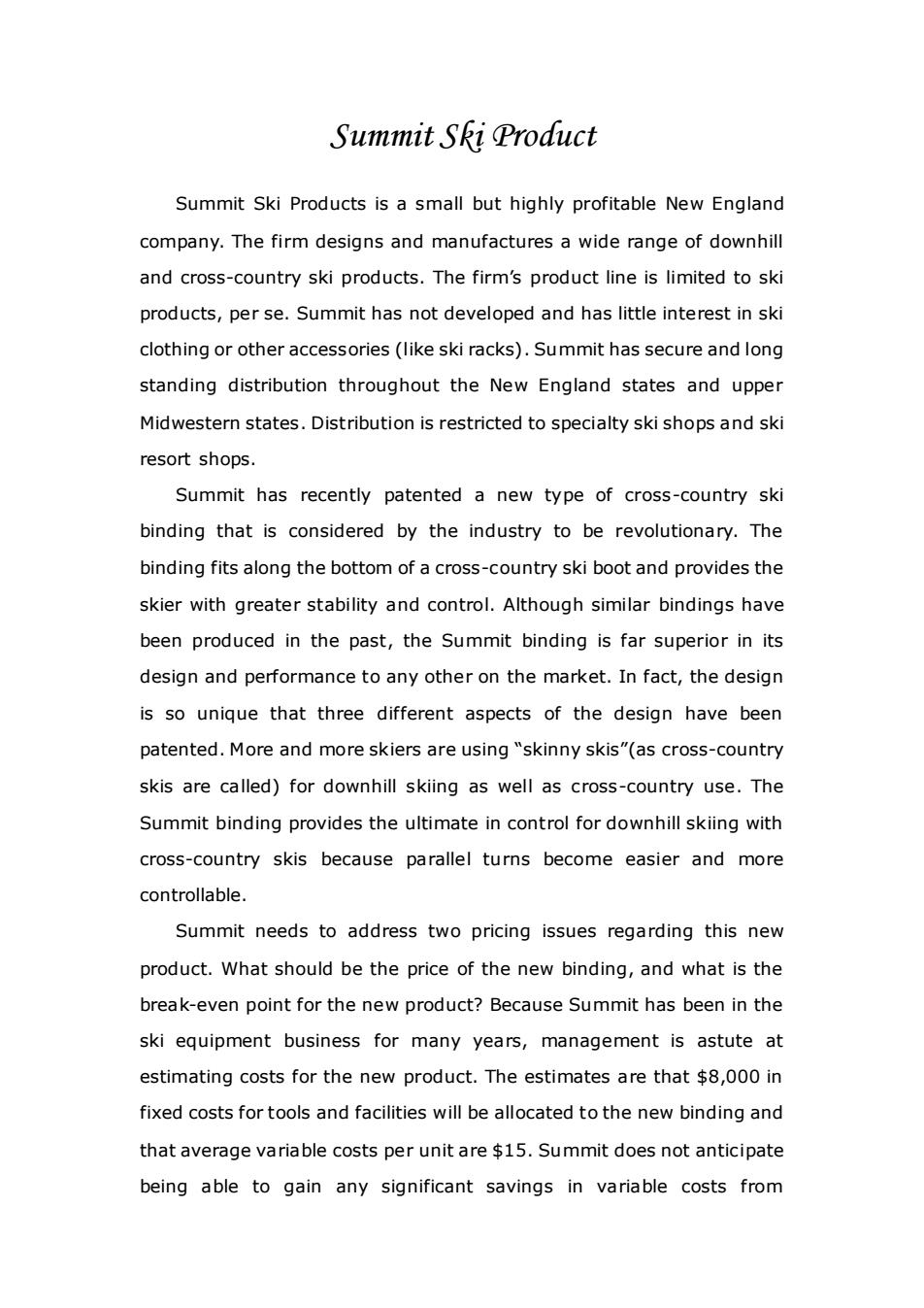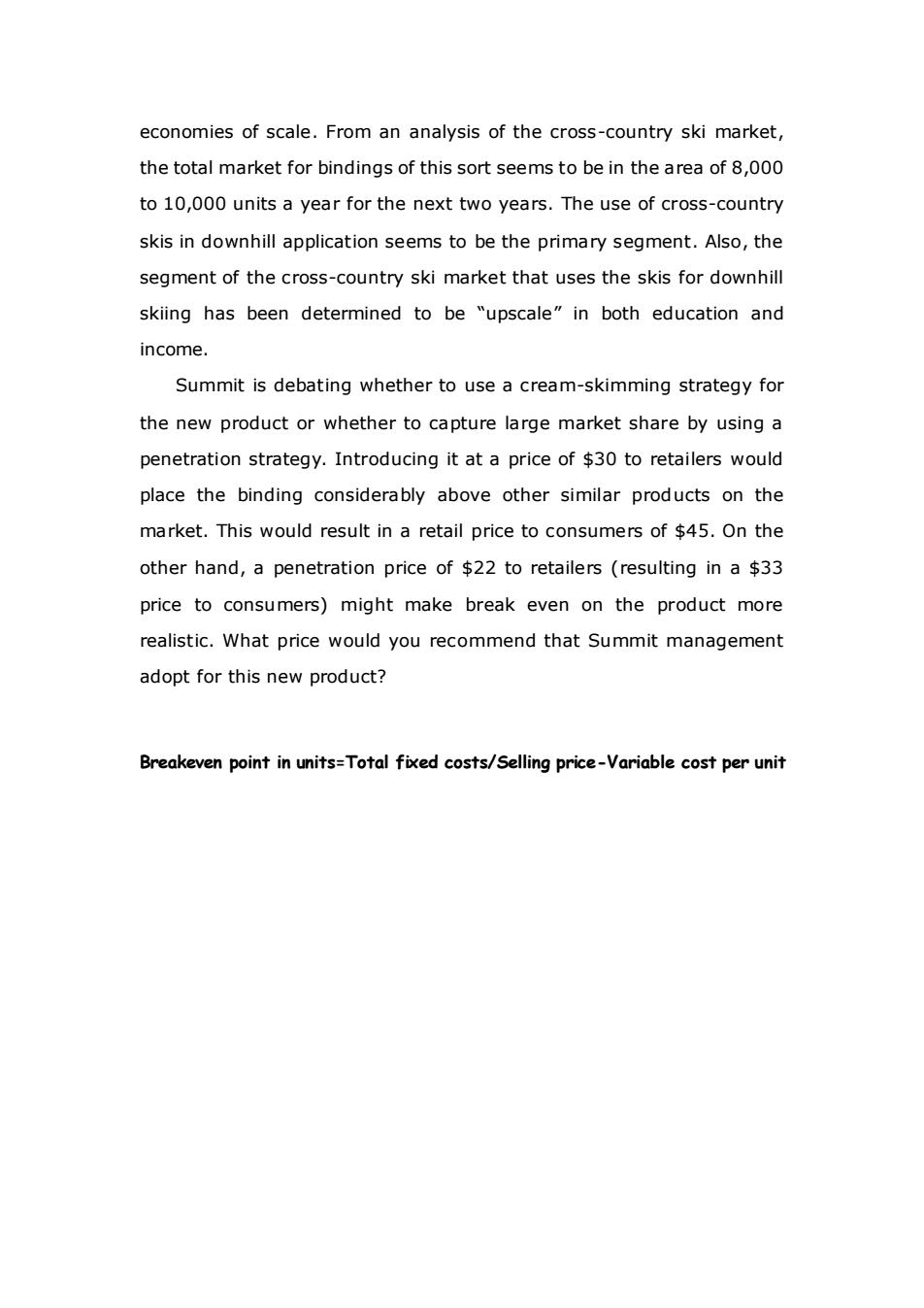
Summit Ski Product Summit Ski Products is a small but highly profitable New England company.The firm designs and manufactures a wide range of downhill and cross-country ski products.The firm's product line is limited to ski products,per se.Summit has not developed and has little interest in ski clothing or other accessories(like ski racks).Summit has secure and long standing distribution throughout the New England states and upper Midwestern states.Distribution is restricted to specialty ski shops and ski resort shops Summit has recently patented a new type of cross-country ski binding that is considered by the industry to be revolutionary.The binding fits along the bottom of a cross-country ski boot and provides the skier with greater stability and control.Although similar bindings have been produced in the past,the Summit binding is far superior in its design and performance to any other on the market.In fact,the design is so unique that three different aspects of the design have been patented.More and more skiers are using"skinny skis"(as cross-country skis are called)for downhill skiing as well as cross-country use.The Summit binding provides the ultimate in control for downhill skiing with cross-country skis because parallel turns become easier and more controllable. Summit needs to address two pricing issues regarding this new product.What should be the price of the new binding,and what is the break-even point for the new product?Because Summit has been in the ski equipment business for many years,management is astute at estimating costs for the new product.The estimates are that $8,000 in fixed costs for tools and facilities will be allocated to the new binding and that average variable costs per unit are $15.Summit does not anticipate being able to gain any significant savings in variable costs from
Summit Ski Product Summit Ski Products is a small but highly profitable New England company. The firm designs and manufactures a wide range of downhill and cross-country ski products. The firm’s product line is limited to ski products, per se. Summit has not developed and has little interest in ski clothing or other accessories (like ski racks). Summit has secure and long standing distribution throughout the New England states and upper Midwestern states. Distribution is restricted to specialty ski shops and ski resort shops. Summit has recently patented a new type of cross-country ski binding that is considered by the industry to be revolutionary. The binding fits along the bottom of a cross-country ski boot and provides the skier with greater stability and control. Although similar bindings have been produced in the past, the Summit binding is far superior in its design and performance to any other on the market. In fact, the design is so unique that three different aspects of the design have been patented. More and more skiers are using “skinny skis”(as cross-country skis are called) for downhill skiing as well as cross-country use. The Summit binding provides the ultimate in control for downhill skiing with cross-country skis because parallel turns become easier and more controllable. Summit needs to address two pricing issues regarding this new product. What should be the price of the new binding, and what is the break-even point for the new product? Because Summit has been in the ski equipment business for many years, management is astute at estimating costs for the new product. The estimates are that $8,000 in fixed costs for tools and facilities will be allocated to the new binding and that average variable costs per unit are $15. Summit does not anticipate being able to gain any significant savings in variable costs from

economies of scale.From an analysis of the cross-country ski market, the total market for bindings of this sort seems to be in the area of 8,000 to 10,000 units a year for the next two years.The use of cross-country skis in downhill application seems to be the primary segment.Also,the segment of the cross-country ski market that uses the skis for downhill skiing has been determined to be "upscale"in both education and income. Summit is debating whether to use a cream-skimming strategy for the new product or whether to capture large market share by using a penetration strategy.Introducing it at a price of $30 to retailers would place the binding considerably above other similar products on the market.This would result in a retail price to consumers of $45.On the other hand,a penetration price of $22 to retailers(resulting in a $33 price to consumers)might make break even on the product more realistic.What price would you recommend that Summit management adopt for this new product? Breakeven point in units=Total fixed costs/Selling price-Variable cost per unit
economies of scale. From an analysis of the cross-country ski market, the total market for bindings of this sort seems to be in the area of 8,000 to 10,000 units a year for the next two years. The use of cross-country skis in downhill application seems to be the primary segment. Also, the segment of the cross-country ski market that uses the skis for downhill skiing has been determined to be “upscale” in both education and income. Summit is debating whether to use a cream-skimming strategy for the new product or whether to capture large market share by using a penetration strategy. Introducing it at a price of $30 to retailers would place the binding considerably above other similar products on the market. This would result in a retail price to consumers of $45. On the other hand, a penetration price of $22 to retailers (resulting in a $33 price to consumers) might make break even on the product more realistic. What price would you recommend that Summit management adopt for this new product? Breakeven point in units=Total fixed costs/Selling price-Variable cost per unit